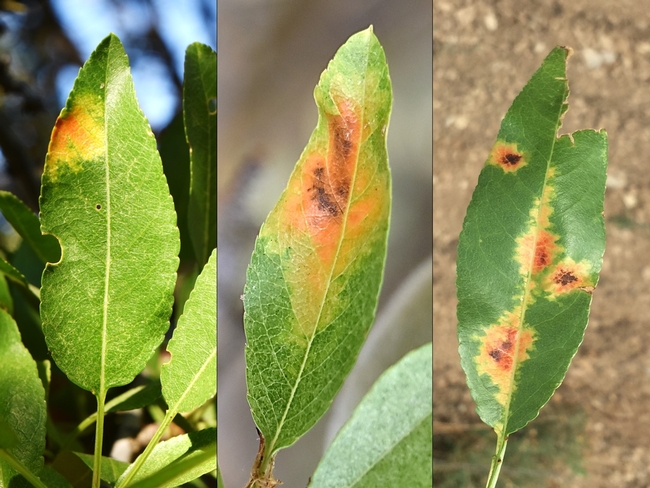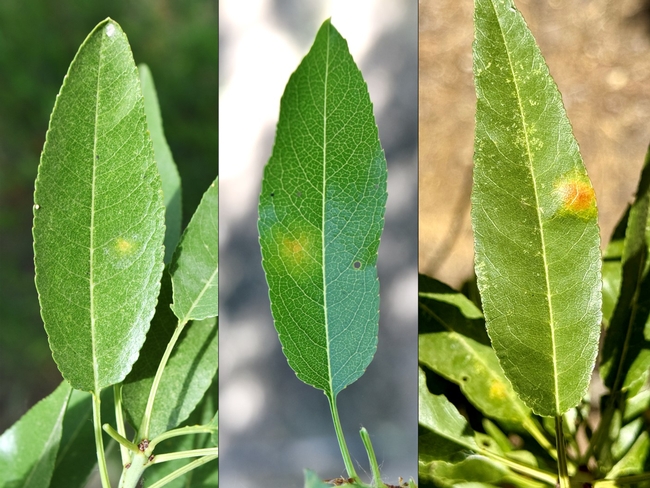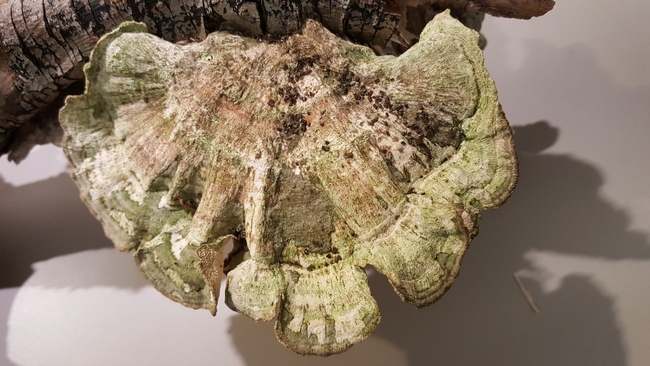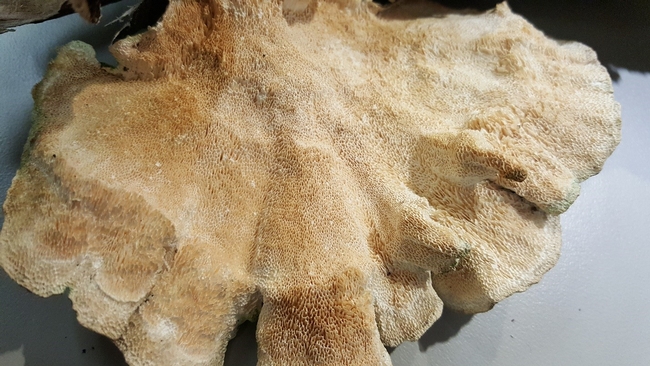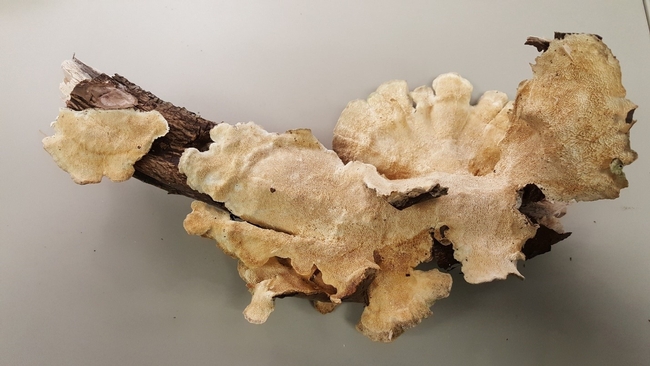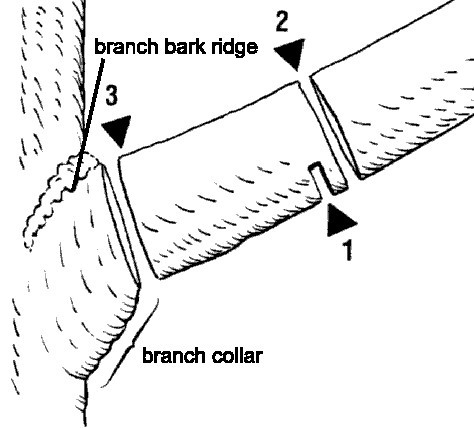Posts Tagged: fungus
Almond crop yields threatened by disease new to California
Detection of fungus causing red leaf blotch spurs call for grower vigilance
Symptoms of red leaf blotch (RLB), a plant disease caused by the fungus Polystigma amygdalinum, have been observed for the first time in California across the Northern San Joaquin Valley.
Molecular DNA testing by the laboratory of Florent Trouillas, University of California Cooperative Extension fruit and nut crop pathology specialist, has detected P. amygdalinum. Pest identification was confirmed by the California Department of Food and Agriculture and U.S. Department of Agriculture.
The disease, named for the characteristic orange-to-dark red blotches that appear on infected leaves, is typically nonlethal for trees but has been a long-standing problem for almond-growing regions across the Mediterranean. Causing trees to lose their leaves prematurely, the fungal pathogen can significantly diminish crop yields in the current year and the next.
“It is one of the most severe diseases of almonds for Spain and the Middle East,” said Trouillas, an associate professor in the UC Davis Department of Plant Pathology. He recently co-authored an explanatory article on the UCCE San Joaquin Valley Trees and Vines blog.
With symptomatic trees seen in multiple orchards across Madera, Merced, San Joaquin and Stanislaus counties, Trouillas said RLB is already “somewhat widespread.”
“From the first observations so far, it seems like it affects some of the most-planted cultivars, like Nonpareil and Monterey,” he added. “We've observed it in a diversity of cultivars already.”
UC Cooperative Extension specialist urges taking preventive measures
According to Trouillas, RLB caused by P. amygdalinum is “highly specific” to almond trees, and generally only affects their leaves. Infection typically happens at petal fall, when small leaflets are first emerging and most susceptible to disease. After the pathogen's latent period of about 35 to 40 days, the first symptoms appear – small, pale-yellow spots on both sides of the leaves.
Those blotches become yellow-orange and then reddish-brown in the advanced stages of the disease during June and July. Now, with RLB symptoms becoming more prominent, Trouillas and UC Cooperative Extension advisors across the Central Valley have seen an uptick in calls.
“PCAs [pest control advisers] have been confused because they've never seen anything like this,” said Trouillas, noting that the yellow-orange-red blotches are symptoms unique to RLB and cannot be confused with other known almond diseases.
Applying fungicides after RLB symptoms appear is ineffective, Trouillas said. The best thing growers can do at this point is to report symptomatic trees to researchers so they can track the prevalence and distribution of the disease.
Growers who see signs of this new disease in their orchard should contact their local UC Cooperative Extension farm advisor.
Preventive measures are the best way to manage RLB, Trouillas said. He urges concerned growers to think ahead to next winter/spring and plan for fungicide applications at petal fall and – if rains persist – also at two weeks and five weeks after petal fall. Fortunately, those are the same three key timings for managing other diseases, like shot hole and almond anthracnose.
“Because RLB is something that is introduced and potentially aggressive, it will be important for growers to keep that in mind next year and be on schedule for next year's spraying program,” Trouillas said.
Additional information on RLB can be found at https://www.sjvtandv.com/blog/first-detection-of-red-leaf-blotch-a-new-disease-of-almond-in-california.
Lawn-pocalypse! Surviving Drought
Ah, summer! The season of sunburns, pool parties, and… lawn droughts. If your once lush, green carpet now looks like a crunchy brown doormat, you're not alone. Let's dive into why your yard is staging a dramatic death scene and what you can do to...

Bermuda grass and weeds overtaking drought stressed turf grass.
Fungus in the Field
Field Finds: Fungus Among Us
Siomara Zendejas, Ventura County UCCE SRA
I stumbled upon this delightful find while doing some field work in an avocado orchard. The light coming in through the canopy made it very easy to spot the branch among the leaf litter. It seemed to be a sort of shelf fungus that either settled in after the branch fell, or was itself the cause for the branch falling. I thought the decorated portion of branch would be harder to break off, but it was surprisingly easy because the wood inside was all soft and spongy, probably due to white rot. Even with all the rain we had this spring, it was still a surprise to find this treasure! Especially considering it was already dry by the time I found it.
Our own Dr. Jim Downer mentioned it could possibly be a member of the Trametes genus, which has a widespread distribution and contains roughly 50 species.The mushroom could potentially be Trametes hirsuta (hairy bracket), or Trametes versicolor (the famous turkey tail fungus). Both fungi can cause white rot and appear green due to tiny algae growing on their top surface. There are also two other look-alike fungi: Stereum ostrea (the false turkey-tail) and Trametes betulina (multicolor gill polypore). However, Stereum ostrea has no pores underneath and Trametes betulina has gills; my mushroom has many pores in its underside!
Fig 1. The top of the mushroom cap with green algae coloring it
Fig 2. Pores on bottom side of fungus
Fig 3. Underside of fungus distributed along dead branch
White rot, for those fortunate enough to have never found it in their trees, is a fungal disease that eats away at both the lignin and the cellulose of a tree. Both of these are very important compounds that give trees their strength and structure. The rot leaves the inner wood feeling spongy and soft, and appears pale or white. The danger of this rot, besides the potential death of the tree, is that infected branches or whole trees can fall despite looking healthy on the outside. The UCANR website has wonderful resources on how to identify and manage different kinds of rots that I'll include here: https://ipm.ucanr.edu/PMG/PESTNOTES/pn74109.html A common result of poor pruning practice, or due to branch damage, is a residual stub that can easily be infected by these fungi. Prompt attention to this damaged wood can prevent infection along with good proper pruning, as indicated in the diagram below.
Remove a branch by making the pruning cut just outside the branch bark ridge and branch collar, as indicated by number 3. When removing a limb larger than about 2 inches in diameter, make three cuts in the order indicated. Make the first cut from below, about one-fourth of the way through the limb and 1 or 2 feet from the trunk. Make the second cut about 2 inches beyond the first cut, cutting from above until the limb drops. Make the final cut at number 3.
It may be worth it to keep a look out for any mushroom laden branches or suspicious stubs, because the can signal a deeper problem underneath the surface. We had a wet spring this year and many a mushroom flourished during that time! For now, this mushroom will be sitting on my desk as both a lovely decoration and a reminder to keep my eyes peeled for the next field find.
Climate-Change Resources
University of California UC ANR Green Blog (Climate Change and Other Topics) https://ucanr.edu/blogs/Green/index.cfm?tagname=climate%20change (full index)
Examples:
- Save Trees First: Tips to Keep Them Alive Under Drought https://ucanr.edu/b/~CdD
- Landscaping with Fire Exposure in Mind: https://ucanr.edu/b/~G4D
- Cities in California Inland Areas Must Make Street Tree Changes to adapt to Future Climate https://ucanr.edu/b/~oF7
Drought, Climate Change and California Water Management Ted Grantham, UC Cooperative Extension specialist (23 minutes) https://youtu.be/dlimj75Wn9Q
Climate Variability and Change: Trends and Impacts on CA Agriculture Tapan Pathak, UC Cooperative Extension specialist (24 minutes) https://youtu.be/bIHI0yqqQJc
California Institute for Water Resources (links to blogs, talks, podcasts, water experts, etc.) https://ciwr.ucanr.edu/California_Drought_Expertise/
UC ANR Wildfire Resources (publications, videos, etc.) https://ucanr.edu/News/For_the_media/Press_kits/Wildfire/ (main website)
-UC ANR Fire Resources and Information https://ucanr.edu/sites/fire/ (main website)
-Preparing Home Landscaping https://ucanr.edu/sites/fire/Prepare/Landscaping/
UC ANR Free Publications https://anrcatalog.ucanr.edu/ (main website)
- Benefits of Plants to Humans and Urban Ecosystems: https://anrcatalog.ucanr.edu/pdf/8726.pdf
-Keeping Plants Alive Under Drought and Water Restrictions (English version) https://anrcatalog.ucanr.edu/pdf/8553.pdf
(Spanish version) https://anrcatalog.ucanr.edu/pdf/8628.pdf
- Use of Graywater in Urban Landscapes https://anrcatalog.ucanr.edu/pdf/8536.pdf
- Sustainable Landscaping in California https://anrcatalog.ucanr.edu/pdf/8504.pdf
Other (Non-UC) Climate Change Resources
Urban Forests and Climate Change. Urban forests play an important role in climate change mitigation and adaptation. Active stewardship of a community's forestry assets can strengthen local resilience to climate change while creating more sustainable and desirable places to live. https://www.fs.usda.gov/ccrc/topics/urban-forests
Examining the Viability of Planting Trees to Mitigate Climate Change (plausible at the forest level) https://climate.nasa.gov/news/2927/examining-the-viability-of-planting-trees-to-help-mitigate-climate-change/
Reports and other information resources coordinated under the auspices of the United Nations and produced through the collaboration of thousands of international scientists to provide a clear and up to date view of the current state of scientific knowledge relevant to climate change. United Nations Climate Action
Scientific reports, programs, action movements and events related to climate change. National Center for Atmospheric Research (National Science Foundation)
Find useful reports, program information and other documents resulting from federally funded research and development into the behavior of the atmosphere and related physical, biological and social systems. Search and find climate data from prehistory through to an hour ago in the world's largest climate data archive. (Formerly the "Climatic Data Center") National Centers for Environmental Information (NOAA)
Think tank providing information, analysis, policy and solution development for addressing climate change and energy issues (formerly known as the: "Pew Center on Global Climate Change"). Center for Climate & Energy Solutions (C2ES)
Mapping Resilience: A Blueprint for Thriving in the Face of Climate Disaster. The Climate Adaptation Knowledge Exchange (CAKE) was launched in July 2010 and is managed by EcoAdapt, a non-profit with a singular mission: to create a robust future in the face of climate change by bringing together diverse players to reshape planning and management in response to rapid climate change. https://www.cakex.org/documents/mapping-resilience-blueprint-thriving-face-climate-disaster
Cal-Adapt provides a way to explore peer-reviewed data that portrays how climate change might affect California at the state and local level. We make this data available through downloads, visualizations, and the Cal-Adapt API for your research, outreach, and adaptation planning needs. Cal-Adapt is a collaboration between state agency funding programs, university and private sector researchers https://cal-adapt.org/
Find reports, maps, data and other resources produced through a confederation of the research arms of 13 Federal departments and agencies that carry out research and develop and maintain capabilities that support the Nation's response to global change. Global Change (U.S. Global Change Research Program)
The Pacific Institute is a global water think tank that combines science-based thought leadership with active outreach to influence local, national, and international efforts to develop sustainable water policies. https://pacinst.org/our-approach/
Making equity real in climate adaptation and community resilience policies and programs: a guidebook. https://greenlining.org/publications/2019/making-equity-real-in-climate-adaption-and-community-resilience-policies-and-programs-a-guidebook/
Quarterly CA Climate Updates and CA Drought Monitor Maps (updated each Thursday) https://www.drought.gov/documents/quarterly-climate-impacts-and-outlook-western-region-june-2022
Lawn Toadstools and Fungi
If mushrooms or toadstools have suddenly appeared up in your yard, you are probably wondering why, and what you can do about them. Mushrooms, toadstools, and other fungi reproduce not by seeds, but by spores. These are microscopic, often single-cell...

